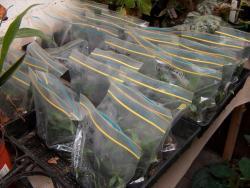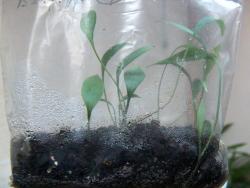Joebass said:Paul please expound further on Joe Hoell's no cold period method! What happens and why was it amazing? Thanks.
G'day Joe--Joe Hoell's method of NO cold period with the delayed hypogeal seed of oriental species and their hybrids was simply, after the 3 month warm period, he would immediately remove the tiny bulblets from their baggies and expose them to morning light and air by placing them on top of fresh (green) wet sphagnum moss(uncovered) and within 2 days they sent up their first leaf,often the bulblet and roots turning a bright green.Proving that under certain conditions, they don't need a cold period to break dormancy.
I decided last year to give it a go.Since being at this property for the last 4 years and not having the facilities in previous years, I found that I lost an unacceptable amount of first year oriental seedlings, mainly due to wind.So I thought how can I modify Joe's experiment to suit my needs.Joe identified the cause and effect--- light and exposure to air after warm period = immediate leaf growth.
This is what I did.Seed was soaked for not more than 5 days (Joe did not soak) then placed in a baggie with damp vermiculite--1small handful, making sure seeds were at the bottom and only lightly covered.Baggies left at room temperature less than 18c.This was on 30 May 2014. Beginning of Sept, they were relocated to a well lit window area, spaced out so all baggies got direct light. With me, leaf development began within 2 weeks and at about 1 cm length,(24 Sept 2014) I started to add DRY sterilised seed raising mix to about 2.5cm deep (1 inch).It had to be dry, or you risk breaking the fragile leaf growth.This soil was later sprayed damp.On each bag, I wrote the number of leaves that commenced growth before the addition of soil and recorded the info in the breeding book. I had decided to attempt as much growth as possible keeping them in the baggies, so they were moved to my makeshift orchid house.The only one that did not break dormancy, and a very special one at that, was martagon distichum (they are ok, just dormant still). By keeping them growing "in the green" in the baggies for maybe 9 months, I will avoid the first year losses due to wind and get at least an extra 3 months growth.
And yes, I was amazed that it was so easy and have never had such growth on first year oriental seedlings.Check out the pictures taken in the last day or so.
This was easier than Joe's method, but the same principle.Forgot to mention, bags left open (after the warm period), bottom corners snipped (tiny cut) and holes poked through the bottom with a satay stick.
The scientific explanation was reported in the British scientific journal ''Nature'' and you may read Joe's article in the 2005 NALS Year Book.





